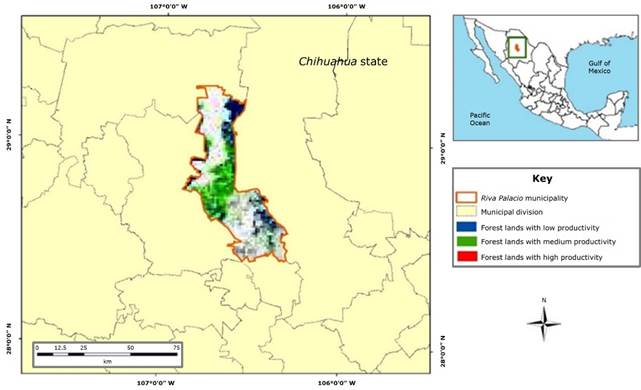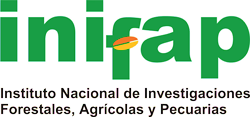Age and diameter jump estimation: a comparison between field and dendrochronological procedures
DOI:
https://doi.org/10.29298/rmcf.v16i88.1505Keywords:
Age, aereal biomass, forestry biometry, dendrochronology, radial increment, diameter jump ageAbstract
The aerial biomass in temperate forests of Mexico is determined in the field, where age and radial growth are important variables involved in this process; however, its determination is usually inaccurate. The objective of this study was to compare the age estimated by eye ring counting (field method) in comparison to the age determined by dendrochronological techniques for two pine species, Pinus arizonica (Pa), and Pinus cembroides (Pc). A systematic sampling design was used to select 25 Pa and 17 Pc trees in the municipality of Riva Palacio, Chihuahua state. Trees were felled and cross-sections obtained at different heights along the stem. Age of each cross-section was determined by the field method and alternatively by dendrochronological techniques. The average difference in years for cross-sections of Pa was 16 years (SD=6.9) and 100 years for Pc (SD=73.4). In terms of diameter jump age for the last 5.0 cm, the results indicated an annual radial growth rate of 0.25 cm year-1 and 0.12 cm year-1 for Pa and Pc, respectively. The “t” test for the estimated ages showed significant difference (p<0.01) among age estimation methods and species. Age determination with the field method for different diameter-size classes is inaccurate and overestimate aboveground biomass, particularly for slow-growing species such as Pinus cembroides.
Downloads
References
Alteyrac, J., Zhang, S. Y., Cloutier, A., & Ruel, J. C. (2005). Influence of stand density on ring width and wood density at different sampling heights in black spruce (Picea mariana (Mill.) B.S.P.). Wood and Fiber Science, 37(1), 83-94. https://wfs.swst.org/index.php/wfs/article/view/220
Álvarez G., J. G., Barrio A., M., Diéguez A., U., y Rojo A., A. (2004). Metodología para la construcción de curvas de calidad de estación. Cuadernos de la Sociedad Española de Ciencias Forestales, (18), 303-309. https://doi.org/10.31167/csef.v0i18.9475
Cook, E. R. (1987). The decomposition of tree-ring series for environmental studies. Tree-Ring Bulletin, 47, 37-59. https://repository.arizona.edu/handle/10150/261788
Correa-Díaz, A., Villanueva-Díaz, J., Gómez-Guerrero, A., Martínez-Bautista, H., Castruita-Esparza, L. U., Horwath, W. R., & Silva, L. C. R. (2023). A comprehensive resilience assessment of Mexican tree species and their relationship with drought events over the last century. Global Change Biology, 29(13), 3652-3666. https://doi.org/10.1111/gcb.16705
Fritts, H. C. (1976). Tree rings and climate. Academic Press. https://www.sciencedirect.com/book/9780122684500/tree-rings-and-climate
Gernandt, D. S., y Pérez-de la Rosa, J. A. (2014). Biodiversidad de Pinophyta (coníferas) en México. Revista Mexicana de Biodiversidad, (Supl. 85), S126-S133. https://doi.org/10.7550/rmb.32195
Grissino-Mayer, H. D. (2001). Evaluating crossdating accuracy: A manual and tuitorial for the computer program COFECHA. Tree-Ring Bulletin, 57(2), 205-221. https://repository.arizona.edu/handle/10150/251654
Hernández, F. J., Meraz A., J. C., Vargas L., B., y Najera L., J. A. (2020). Crecimiento en diámetro, altura, área basal y volumen para tres especies de pino en Chihuahua, México. Revista Mexicana de Ciencias Forestales1, 1(60), 120-143. https://doi.org/10.29298/rmcf.v11i60.711
Hernández-Ramos, J., Hernández-Ramos, A., Ordaz-Ruiz, G., García-Espinoza, G. G., García-Magaña, J. J., y García-Cuevas, X. (2022). Índice de sitio para plantaciones forestales de Pinus patula en el Estado de México. Madera y Bosques, 28(2), Artículo e2822308. https://doi.org/10.21829/myb.2022.2822308
Hu, M., Lehtonen, A., Minunno, F., & Mäkelä, A. (2020). Age effect on tree structure and biomass allocation in Scots pine (Pinus sylvestris L.) and Norway spruce (Picea abies [L.] Karst.). Annals of Forest Science, 77, Article 90. https://doi.org/10.1007/s13595-020-00988-4
Imaña E., J., y Encinas B., O. (2008). Epidometría forestal. Universidad de Brasilia. https://www.monografias.com/trabajos-pdf2/epidometria-forestal/epidometria-forestal.pdf
Instituto Nacional de Estadística y Geografía. (2010). Compendio de información geográfica municipal 2010. Riva Palacio, Chihuahua. Clave geoestadística 08054. INEGI. http://www3.inegi.org.mx/contenidos/app/mexicocifras/datos_geograficos/08/08054.pdf
Jones, K. W., Avila F., S., Pischke, E. C., Salcone, J., Torrez, D., Selfa, T., & Halvorsen, K. E. (2019). Exploring the connections between participation in and benefits from payments for hydrological services programs in Veracruz state, Mexico. Ecosystem Services, 35, 32-42. https://doi.org/10.1016/j.ecoser.2018.11.004
Klepac, D. (1983). Crecimiento e incremento de árboles y masas forestales. Universidad Autónoma Chapingo. http://dicifo.chapingo.mx/pdf/publicaciones/crecimiento_e_incremento_klepac_dusan.pdf
NOM-152-SEMARNAT-2023. (2023, 16 de junio). NORMA Oficial Mexicana NOM-152-SEMARNAT-2023, Que establece los criterios y especificaciones del contenido de los programas de manejo forestal sustentable para el aprovechamiento de recursos forestales maderables en bosques, selvas y vegetación de zonas áridas. Diario Oficial de la Federación, 24 de julio de 2023. https://www.dof.gob.mx/nota_detalle.php?codigo=5696430&fecha=24/07/2023#gsc.tab=0
Organización de las Naciones Unidas para la Alimentación y la Agricultura. (2018). El estado de los bosques del mundo. Las vías forestales hacia el desarrollo sostenible. ONUAA. https://openknowledge.fao.org/items/7209f244-84c9-4191-b2f9-51d7449fcc62
Pérez-Olvera, C. de la P., y Dávalos-Sotelo, R. (2016). Anatomía de la madera de seis especies de Pinus (Pinaceae) del estado de Durango, México. Madera y Bosques, 22(3), 113-132. https://doi.org/10.21829/myb.2016.2231460
Quiñonez B., G., De los Santos P., H. M., y Álvarez G., J. G. (2015). Crecimiento en diámetro normal para Pinus en Durango. Revista Mexicana de Ciencias Forestales, 6(29), 108-125. https://doi.org/10.29298/rmcf.v6i29.220
Robinson, W. J., & Evans, R. (1980). A microcommputer-based tree-ring measuring system. Tree-Ring Bulletin, 40, 59-64. https://repository.arizona.edu/handle/10150/260443
Sánchez-González, A. (2008). Una visión actual de la diversidad y distribución de los pinos de México. Madera y Bosques, 14(1), 107-120. https://doi.org/10.21829/myb.2008.1411222
Santiago-García, W., Ángeles-Pérez, G., Quiñonez-Barraza, G., De los Santos-Posadas, H. M., y Rodríguez-Ortíz, G. (2020). Avances y perspectivas en la modelación aplicada a la planeación forestal en México. Madera y Bosques, 26(2), Artículo e2622004. https://doi.org/10.21829/myb.2020.2622004
Schweingruber, F. H. (1996). Tree rings and environment. Dendroecology. University of Minnesota. https://books.google.com.mx/books/about/Tree_Rings_and_Environment_Dendroecology.html?id=zNYsAQAAMAAJ&redir_esc=y
Stokes, M. A., & Smiley,T. L. (1996). An introductión to tree-ring dating. The University of Arizona Press. https://books.google.com.mx/books?id=SvBF2Ora-eUC&printsec=frontcover&hl=es&source=gbs_ge_summary_r&cad=0#v=onepage&q&f=false
Tamarit-Urias, J. C., De los Santos-Posadas, H. M., Aldrete, A., Valdez-Lazalde, J. R., Ramírez-Maldonado, H., y Guerra-De la Cruz, V. (2019). Sistema de crecimiento y rendimiento maderable para plantaciones de teca (Tectona grandis L. f.) en Campeche, México. Madera y Bosques, 25(3), Artículo e2531908. https://doi.org/10.21829/myb.2019.2531908
Upadhyay, K. K., & Tripathi, S. K. (2019). Sustainable forest management under climate change: a dendrochronological approach. Environment and Ecology, 37(3B), 998-1006. https://www.researchgate.net/publication/350724375_Sustainable_Forest_Management_under_Climate_Change_A_Dendrochronological_Approach
Zárate-Castrejón, J., González-Pacheco, B., Ruiz-Nieto, J., Ávila-Ramos, L., y Ávila-Ramos, F. (2021). El árbol Pinus cembroides como alternativa para reforestar ciudades, parques y jardines. Abanico Agroforestal, 3, 1-12. http://dx.doi.org/10.37114/abaagrof/202.1

Downloads
Published
How to Cite
Issue
Section
License
Copyright (c) 2025 Revista Mexicana de Ciencias Forestales

This work is licensed under a Creative Commons Attribution-NonCommercial 4.0 International License.
The authors who publish in Revista Mexicana de Ciencias Forestales accept the following conditions:
In accordance with copyright laws, Revista Mexicana de Ciencias Forestales recognizes and respects the authors’ moral right and ownership of property rights which will be transferred to the journal for dissemination in open access.
All the texts published by Revista Mexicana de Ciencias Forestales –with no exception– are distributed under a Creative Commons License Attribution-NonCommercial 4.0 International (CC BY-NC 4.0), which allows third parties to use the publication as long as the work’s authorship and its first publication in this journal are mentioned
The author(s) can enter into independent and additional contractual agreements for the nonexclusive distribution of the version of the article published in Revista Mexicana de Ciencias Forestales (for example, include it into an institutional repository or publish it in a book) as long as it is clearly and explicitly indicated that the work was published for the first time in Revista Mexicana de Ciencias Forestales.
For all the above, the authors shall send the form of Letter-transfer of Property Rights for the first publication duly filled in and signed by the author(s). This form must be sent as a PDF file to: ciencia.forestal2@inifap.gob.mx
This work is licensed under a Creative Commons Attribution-Noncommercial 4.0 International license.





